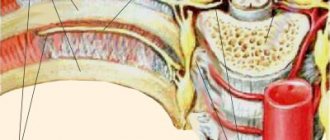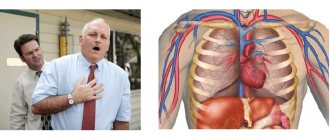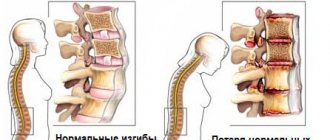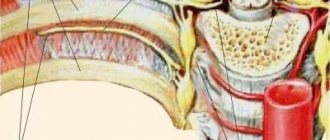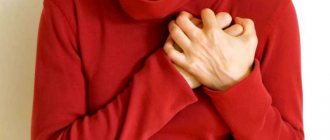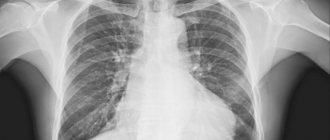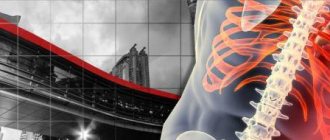Spinal problems
Chest pain when inhaling often appears due to pathologies of the spinal column. The fact is that the spine contains a huge number of nerve endings, inflammation and/or infringement of which can lead to pain radiating into the chest, causing pain when inhaling.
Osteochondrosis
It is a serious disease that affects the cartilage tissue of the spinal column. The intervertebral discs thin out and become less durable, resulting in a decrease in the distance between the vertebrae. Because of this, nerve tissue is pinched, which leads to pain. If the pain intensifies when you inhale, this may indicate that the thoracic spine is affected.
Intercostal neuralgia
Sharp acute pain in the chest when inhaling occurs when compression or irritation of the nerve roots that are located between the ribs occurs. This condition can last literally a couple of minutes or drag on for a day, preventing the person from taking a deep breath and causing significant discomfort. The pain can come on suddenly, for no apparent reason, and often makes a person worry and think that the heart is stabbing, although the reason is completely different.
Fractured ribs
If you have recently been injured and experience pain in your chest when you inhale, you may suspect a rib fracture. This is a dangerous condition, and with a visit to a traumatologist
/
the surgeon
cannot hesitate, since, among other things, you may have damage to internal organs. The fracture itself, depending on its severity, can provoke additional damage.
Diagnostics
Only a clinician can find out the sources against which pain manifested itself in the heart, back, trachea, stomach and chest, as well as in the left or right hypochondrium, based on data obtained during a comprehensive diagnosis.
At the first appearance of acute pain syndrome, you should seek help from a therapist, who, if necessary, will refer the patient for consultations with specialists from narrower fields of medicine.
General primary diagnosis should include:
Performing an ultrasound of the abdominal cavity
- studying the medical history - for the possible identification of a chronic pathological process that could serve as a trigger for the occurrence of pain;
- collection and analysis of life history;
- a thorough examination of the patient, which must necessarily be aimed at palpating the problem area, listening to the patient, as well as assessing the condition of the skin, measuring temperature and blood pressure;
- a detailed survey of the person - so that the doctor understands how a particular disease progresses;
- general clinical analysis and blood biochemistry;
- general urine analysis;
- microscopic examination of feces;
- Ultrasound of the peritoneum;
- X-ray of the chest area;
- CT and MRI of the spine.
Depending on the information obtained from the above examinations, the patient may be referred for additional examinations to:
- nephrologist;
- gastroenterologist;
- vertebrologist;
- pediatrician;
- pulmonologist;
- orthopedist
Each clinician will prescribe specific laboratory and instrumental diagnostic procedures.
Diseases and pathologies of the heart
Often, when inhaling, pain appears in the left chest if there is a heart problem. In this case, there may be quite a few reasons, and only an experienced pulmonologist
.
Pericarditis
Pericarditis is an inflammation of the heart sac - the outer lining of the heart, which is called the “pericardium”. The nature of such a disease can be infectious, rheumatic, or result from a heart attack. With pericarditis, not only does pain appear when inhaling on the right or left side of the chest; the condition is often accompanied by severe weakness, as well as shortness of breath if fluid leaks between the layers of the pericardium. Pericarditis with effusion can develop into suppuration and cause compression of the heart by accumulated secretions.
Pulmonary embolism
This is the name of the condition when the pulmonary arteries stop passing blood, i.e. clogged. This is a consequence of a blood clot (thrombus), drops of fat, bone marrow, catheter element or other foreign body entering the arterial bed. In this case, when inhaling, pain occurs in the left side of the chest, and the person needs urgent medical attention.
#!NevrologSeredina!#
Why does a person experience pain in the right chest when inhaling and moving?
When the chest hurts when inhaling on the right side, many patients are quite sincerely surprised as to why this “heart reverberates” in the right side of the chest.
Apparently, the nature of the pain - usually sharp, stabbing, burning - gives them reason to think that only the heart can give such severe pain. Chest pain can have many other causes, sometimes no less serious than pathologies of the cardiovascular system (CVS), which you need to know about. What, for example, does pain in the chest on the right when inhaling mean? Why do breathing movements affect the intensity of pain?
General ideas about pain in the chest when inhaling on the right
In this part of the body, pain may be felt in the chest on the right when inhaling and moving from several organs:
- membranes (pleura) of the right lung;
- arteries of the right lung;
- bronchi and bronchioles;
- intercostal muscles.
The activity of these organs is directly or indirectly associated with the movement of the diaphragm - the muscular septum separating the chest and abdominal cavities. When you inhale, it stretches and puts pressure on the abdominal cavity, while the lower part of the superior vena cava and the lining of the heart (pericardium) expand.
With rapid breathing (for example, during intense exercise), the load increases not only on the pericardium, but also on the skeletal muscles of the chest, which, due to overload, can stretch too much and cause pain in the right side of the chest when inhaling.
It is clear that various damage by the pathological process to the organs listed above can manifest as pain.
What does pain in the right side of the chest indicate?
Any painful sensation in the human body indicates that there has been a failure in its smooth functioning:
- an inflammatory process has developed;
- muscle tissue is stretched or torn;
- a pinched nerve;
- the lumen of the vessel is clogged;
- a tumor has formed.
We cannot exclude a traumatic cause of pain in the thoracic region on the right when inhaling, which often does not appear immediately, but some time after the injury.
Why does the right chest hurt?
What pathological conditions can cause pain on the right side of the chest when inhaling?
- Pain in the chest on the right when inhaling is often a consequence of gastroesophageal reflux (dysfunction of the esophageal sphincter).
- Sometimes pain that occurs in the digestive organs radiates (gives) to the right side - for example, in the gallbladder and ducts during cholestasis (stagnation of bile) or cholelithiasis in an advanced stage.
Characteristic features of biliary colic are that they can radiate to the right lower chest, and to the right side of the neck or scapula.
There are many other causes of pain on the right side of the chest when inhaling.
Excessive exercise and stretching
Overloads experienced by the chest muscles often lead to damage to the muscle fibers - their stretching and even microscopic rupture.
As a rule, such microtraumas occur in people involved in strength sports; also, stretching or rupture of muscle fibers can be a consequence of:
- sudden turns of the body;
- other unusual movements;
- falls during outdoor play;
- direct or tangential blows to the thoracic region;
- performing excessively strong exercises without appropriate physical training.
In addition to sports activities, everyday factors, such as lifting excessive loads, can cause muscle damage accompanied by pain in the right chest when breathing.
There are also somatic reasons that provoke pain in the chest on the right when inhaling. They consist of diseases accompanied by bloating, a hysterical cough, or the presence of a diaphragmatic hernia in the area of the esophageal opening.
Neuralgia
If the right side of the chest hurts when you inhale, this is most likely a sign of neuralgia - a painful manifestation when a nerve is pinched. The most common cause of neuralgia is osteochondrosis, a chronic disease of the intervertebral discs and cartilage. Pain in osteochondrosis tends to increase in intensity when moving the limbs.
Other causes of neuralgia:
- stress;
- physical overload;
- hypothermia.
The neuralgic pain in the chest and with a deep breath intensifies on the right.
Injury
Injuries to the bones of the upper skeleton (ribs, clavicle, sternum) can also cause chest pain on the right when inhaling. When the injury causes a violation of the anatomical integrity of the pulmonary membrane or other organs, this often leads to a serious complication - pneumothorax (accumulation of air in the pleural cavity) - also manifested by chest pain on the right when inhaling.
Sometimes a hidden injury is not detected immediately, but after some time, when only an X-ray examination can show the most reliable cause of pain in the thoracic region.
Inflammation of the lung and its membrane
With inflammation of the right lung (pneumonia), right-sided chest pain may also develop. Its cause is irritation of the bronchial nerve receptors by the inflammatory process (these receptors are present in the bronchi, but not in the lungs themselves) or the spread of this process to the pleura. The lining of the lung, like the bronchi, is innervated and with any irritation it signals a problem with pain.
Right pulmonary embolism
The greatest danger of all the listed causes of the pain syndrome in question is pulmonary embolism (in this case, the right lung).
PE is one of the most common acute pathologies of the cardiovascular system and is recognized as a serious medical problem due to the difficulty of diagnosis and treatment. Untreated embolism is fatal in 25–30% of cases.
Causes of pulmonary embolism:
- The most common cause of embolism is thrombophlebitis of the leg veins, the inferior vena cava and its branches, as well as varicose veins and thrombosis of the venous plexuses in the bladder, genital and other pelvic organs.
- Much less commonly, the pulmonary artery is blocked by emboli (blood clots) that have formed in the right chambers of the heart or the superior vena cava.
- One of the common provoking factors for pulmonary embolism is tumor diseases that lead to hypercoagulation of the blood.
This is why it is so important to pay attention to the symptoms when, when inhaling, pain appears in the chest on the upper right side.
Bronchopulmonary tumor
Tumor formations in the bronchi or lungs, united by the general concept of bronchopulmonary cancer, can also provoke pain in the chest on the right when inhaling. The disease can occur in the form of central lung cancer, originating from the bronchi, or peripheral, which developed directly in the lung tissue. Risk factors for developing bronchopulmonary tumors include:
- smoking;
- inflammatory processes (tuberculosis, pulmonary scars, chronic pneumonia, bronchiectasis);
- excessive radiation exposure;
- work in asbestos production.
The presence of severe chest pain, fever and cough is characteristic of peripheral cancer, which is asymptomatic until the tumor increases in size. Central cancer is manifested by a dry hacking cough, which over time transforms into hemoptysis.
Pain when taking a deep breath on the left
What could mean pain in the left side of the chest that gets worse with a deep breath? In this case, it is fair to suspect primarily cardiovascular pathology, but left-sided pain can not only be caused by it. Pain with a deep breath on the left most often develops due to:
- neuralgia and osteochondrosis;
- pneumonia progressing to pleurisy;
- PE of the left lung;
- injuries;
- bronchopulmonary cancer.
The true cause of pain in the thoracic region when inhaling can only be found out after a thorough examination in a medical facility.
For more information about chest pain, watch this video:
Conclusion
- Pain in the chest on the right when inhaling and moving can be a consequence of an inflammatory process, stretching or rupture of muscle fibers, pinched nerves, blockage of a vessel, or the formation of a tumor in the chest organs.
- It is impossible to establish the etiology of pain without thorough diagnostic studies (including, if necessary, radiographic studies).
Source: https://pulmonologiya.com/simptomy/bol-v-gk/sprava-pri-vdohe-i-dvizhenii.html
Pulmonary pathologies
There are many causes of pain in the sternum during inspiration, which are associated with pathologies of the respiratory system. It is worth considering some cases when pain may appear when inhaling.
Pneumothorax
It is an accumulation of gas in the pleural cavity, which leads to the collapse of lung tissue, from which the process occurs. In this case, the mediastinum shifts towards the healthy organ, the blood vessels are compressed, which leads to respiratory disorders, and blood circulation is also impaired. Often pneumothorax is traumatic, and can also be a consequence of spontaneous disruption of tissue integrity.
Pleuropneumonia
If chest pain appears when taking a deep breath, this may indicate progressive pulmonary pneumonia, when the pleura is involved in the pathological process. This disease is very dangerous; Along with pain when inhaling, a person notes the inability to take a deep breath and general weakness.
Pleurisy
Inflammation of the serous membrane of the lungs is called pleurisy and may be accompanied by pain when inhaling. In this case, a person not only has pain in the chest area when inhaling, but also shortness of breath, cough, pulmonologist
notes pleural friction noise when listening to breathing, and the temperature also rises.
Lungs' cancer
Pain in the middle of the chest when inhaling can occur if a malignant neoplasm has developed in the lungs. Pain syndrome is a consequence of tissue proliferation and compression of neighboring structures. To determine why your chest begins to hurt when you inhale and move, first consult a neurologist
, who, after a survey and examination, will refer you to a specialist.
Symptoms
Given that pain during breathing is formed against the background of a wide range of predisposing sources, it is advisable to mention only the main clinical manifestations that may accompany it. This is also due to the fact that even when patients have the same illness, the symptoms may be different.
Thus, the main manifestation is most often supplemented:
- cough, which at the beginning of any disease will be dry, but as it progresses it is often accompanied by sputum;
- attacks of nausea and vomiting;
- increased temperature;
- violation of the act of defecation;
- bloating;
- belching and heartburn;
- shortness of breath, which appears both after physical activity and at rest, as well as in a lying position;
- dizziness and weakness;
- general malaise and decreased performance;
- fluctuations in blood tone;
- heart rate disturbance;
- pallor or yellowness of the skin;
- secretion of a large amount of sweat;
- feeling of lack of air;
- motor function disorder;
- the appearance of “goosebumps” before the eyes;
- fainting;
- convulsions.
It is worth noting that any pathological process in children is more severe and develops faster than in adults.
Other reasons
In addition to the above, pain can occur under the following conditions:
- Intercostal neuralgia. Appears in diseases of the spinal cord, inflammation of the intercostal nerves. Prolonged pain when inhaling throughout the day, it becomes painful to breathe; the pain intensifies when changing position, moving and bending in the painful direction, when touching, palpating, laughing, sneezing, and breathing. The rib muscles are often swollen and enlarged, causing pressure on the nerves. The affected side is very sensitive to the touch. Symptoms can limit the patient's mobility for a long time.
- MPS (myofascial pain syndrome). The pain is only when inhaling, the muscles are spasmodic and painful when palpated.
- Rib fractures. Increased pain when coughing and breathing; it is limited to the fracture site. The area is painful on palpation.
- Chest injuries. Occurs when falling from a height or accident; With bruises, swelling of the soft tissues develops, severe pain appears when inhaling. In case of bruises, an x-ray is required to rule out fractures. With unilateral damage to the ribs, the affected side lags behind when breathing; with rest the pain disappears.
- Krepatura. After intense physical activity, muscle soreness may appear after some time. This is not a disease, although there is pain when inhaling.
- Shingles. A disease of infectious origin. With it, pain in the chest appears a few days before the rash.
- Neoplasms. Lung cancer - acute constant pain when breathing; Pancoast tumor (cancer of the apex of the lung) – the pain is burning, radiating to the upper extremities.
Why does pain occur when you inhale?
There are many causes of discomfort, so it is important to understand what causes it and choose the right treatment. Based on the examination and complaints of the patient, the doctor can make a preliminary conclusion.
Diseases that make breathing painful:
- neurological;
- musculoskeletal;
- gastrointestinal diseases;
- pulmonary
Acute and chronic diseases of the liver and gall bladder may be accompanied by discomfort, but you cannot tolerate and take painkillers on your own.
The chest has a complex structure, because it contains several important organs at once. Failure of any of them can lead to the development of pain. Causes of pain when inhaling:
- rib fracture;
- shingles;
- pancreatitis;
- myositis;
- duodenitis or ulcer;
- cholecystitis;
- neuralgia.
The movable bones of the rib cage expand when you inhale, allowing air to enter the lungs. When the bone structure is damaged, sharp pain occurs, making it difficult to breathe fully. In addition, the sternum is protected by muscle tissue in which nerve endings are located.
Injury or inflammation of the muscles will lead to pain. Pulmonary and heart diseases also provoke pain under the ribs when sighing.
Intercostal neuralgia and pinched nerves
There are many nerve endings running from the spine to the bottom of each rib. Their inflammation or pinching is called intercostal neuralgia. The causes of the development of the disease can be either diseases of the spine (osteochondrosis, spondylitis, hernia), or severe physical or emotional stress or trauma. In addition, neuralgia can occur due to hormonal imbalance and vascular pathology. The patient experiences sharp paroxysmal pain between the ribs when inhaling. Often the pain radiates to the arm, and breathing becomes difficult.
Pain in the chest on the right when inhaling: causes, treatment – Your online doctor
The rib cage is a skeletal system consisting of the ribs and the upper parts of the spine. And the sternum is a flat bone located in the middle of the chest, the ribs are attached to it. But many people who are far from medicine are accustomed to calling the chest the sternum, especially when describing discomfort and pain in the sternum on the right, the causes of which are often associated with the heart.
What does chest pain when coughing indicate?
According to statistics, pain in the sternum on the right is most often associated with pathologies of the respiratory system, musculoskeletal system and nerves, less often the cause lies in diseases of the digestive system.
Acute
Acute pain in the sternum on the right that occurs for the first time or is expected may be accompanied by symptoms that can indirectly determine the cause. Sudden sharp pain in the sternum on the right, accompanied by a cough, may have additional symptoms:
- shortness of breath, shallow or deeper slow breathing;
- noise or wheezing during inhalation/exhalation;
- weakness, dizziness, fainting;
- sputum discharge;
- increased sweating;
- excited state;
- weakness, decreased tolerance to physical activity.
The acute nature of chest pain on the right may indicate the presence of an acute inflammatory process, which requires mandatory consultation with a therapist.
Sharp
Severe pain in the right sternum is usually associated with physical activity or attempts to take a deep breath.
Sometimes the cause of pain is turning the body, lifting and turning the right arm, and physical activity.
These symptoms suggest degenerative diseases of the upper spine, in which irritation of the nerve endings occurs - for example, osteochondrosis.
Aching
The cause of slowly increasing aching pain in the sternum in women on the right and in men may be associated with damage to the bronchopulmonary system. The stomach, liver, pancreas, gall bladder in various diseases give pain in the epigastrium and right hypochondrium. The cause of discomfort in the chest on the right with pathologies of these organs is referred pain, which is quite rare.
Front
Statistically, most often patients feel pain on the right side of the anterior chest due to neurological disorders associated with damage to the peripheral nerves, as well as osteochondrosis of the middle spine. Often the cause of pain in the front of the chest is associated with excessive stress on the pectoral muscles during sports or as a result of heavy physical work.
Concentration of discomfort in the upper chest is an atypical picture. To determine the cause of right sternum pain in a man or woman in the upper front part of the chest, other symptoms need to be analyzed. The pain is associated with damage to the subclavian or axillary lymph nodes, in which it radiates to the upper chest.
If a person has a cough, fever, or decreased physical endurance, then tuberculosis or pneumonia can be suspected.
Causes
To determine the causes of pain in the sternum when inhaling on the right, coughing, moving and other situations, you should always look at the accompanying symptoms. Pathological processes in the lungs, upper respiratory tract, bone and cartilage tissues, as well as neurological diseases can be determined by the location of the pain, the situation in which it occurs, and the duration of the discomfort.
Are common
The combination of chest pain with cough, shortness of breath, high fever, weakness, increased sweating, cyanosis of the skin usually has the following causes:
- right-sided pneumonia;
- lung abscess as a complication of pneumonia or tuberculosis;
- acute bronchitis;
- pleurisy;
- pneumothorax as a consequence of chest injury on the right.
Less commonly, painful sensations in the chest on the right, localized closer to the neck and radiating to the lower jaw, can be a sign of such a dangerous condition as an aortic aneurysm. It is the responsibility of a cardiologist and also requires immediate medical attention.
The cause of pain in the sternum on the right when inhaling, turning the body, bending, lifting and rotating the arm is the development of neurological disorders and pathologies of bone and cartilage tissue.
Among women
Pain in the sternum in women on the right side has the causes described above. Pathologies of the lungs and upper respiratory tract in women occur with the same frequency as in men.
As for neurological, degenerative and inflammatory processes in the thoracic spine, women are predisposed to them just like men, but the causes of these diseases are the underdevelopment of the back muscles, which results in a lack of their supporting function for the spine.
According to statistics, women are more often engaged in sedentary, sedentary work, which causes osteochondrosis due to impaired blood supply.
In men
There is no reason to assert that physiologically men are more predisposed to diseases of the upper respiratory tract, as well as pathologies of the spine and neuralgia, than women. However, the causes of pain in the sternum on the right in men can be determined based on lifestyle, bad habits and work.
Men smoke more often than women, which causes bronchopulmonary diseases - a common cause of chest pain. Other causes of pain in men are associated with stress combined with cold (for example, heavy physical work in the fresh air during the cold season).
It can also be noted that men are less attentive to their health and tend to overestimate their capabilities (for example, endurance and resistance to cold), which is why they more often experience hypothermia, leading to neuralgia.
If there is no temperature
Low-grade and febrile temperature is a response to an acute inflammatory process or infection. Therefore, normal temperature readings with chest pain on the right may indicate chronic respiratory diseases, as well as neuralgia, scoliosis, intervertebral hernia, and ankylosing spondylitis.
When inhaling
Pain on the right side of the sternum above, which occurs when inhaling, indicates either damage to the lung (right-sided pneumonia, pneumothorax, emphysema) or neurological disorders.
The expansive movement of the chest during inhalation, necessary to fill the lungs with air, causes mechanical irritation of the nerve endings of the spine, which provokes pain.
This is one of the typical signs of neuralgia - the cause of chest pain on the right.
When inhaling, chest pain can be intermittent or constant. For example, the patient may feel a sharp, painful prick in the right side of the chest, which will make him freeze and carefully catch his breath.
This is also a common symptom of neuralgia.
Painful sensations of moderate and low intensity can be felt with every breath, which may indicate injuries to the pectoral muscles and/or ribs during sports or physical activity.
If you have a dry cough
Most often, pain in the right side of the chest, accompanied by a cough, is a symptom of bronchopulmonary disease. Less commonly, pain in the sternum on the front right can be neurological in nature when there is a pathology of the esophagus, which reflexively causes coughing.
What to do if there is pain in the sternum when coughing?
If pain and cough do not occur sporadically, but regularly, consultation is necessary. First, it is better to contact a therapist who will conduct an examination and interview, analyze all the signs and symptoms, and identify the cause. If necessary, he will refer the patient to a highly specialized doctor - a pulmonologist, a neurologist.
It is not advisable to take any medications (painkillers, antitussives, anti-inflammatory drugs, antipsychotics) without consulting a doctor.
From the following video you can learn useful information about the treatment of pneumonia:
Other causes of pain in the hypochondrium
There are many diseases that can cause acute pain under the ribs. Cardiac pathologies with pain include angina pectoris, myocarditis, heart attack, and aneurysm. Such diseases require careful diagnosis and immediate treatment. With an aneurysm, pain in the middle of the chest can last up to several days, constantly getting worse.
Angina pectoris and heart attack have common symptoms:
- left sternum pain;
- difficulty breathing;
- cold sweat;
- panic attacks;
- blue lips
A heart attack is characterized by a deep increase in these signs. Myocarditis is accompanied by wave-like pain, disturbances in heart rhythm and breathing. In many ways, the symptoms resemble the clinical picture of a heart attack.
Pathologies of the spine that cause acute pain include ankylosing spondylitis and intercostal chondritis. In the first case, destruction of the nerve fibers of the spine occurs, in the second - inflammation of the intercostal cartilages.
Treatment and prevention
Treatment depends on the pathology:
- for pulmonary embolism, anticoagulants and surgical removal of the thrombus are prescribed;
- for pneumonia, pleurisy, tracheitis - antibacterial and symptomatic therapy, analgesics, immunostimulants;
- for costochondritis - NSAIDs and physiotherapy;
- for CVD - beta blockers, analgesics, anticoagulants.
Pain when breathing may be a symptom of a serious illness. Therefore, if it does not go away, it is better to consult a doctor. And as a preventive measure - a balanced diet, exercise and quitting smoking and alcohol.
Gastrointestinal ailments
Chest pain may occur if the following gastrointestinal pathologies develop:
- Gastroesophageal reflux disease (GERD). The stomach throws its contents into the esophagus after eating. This is especially evident when bending over or lying down. Heartburn is almost always present; it is accompanied by a sore throat, pain behind the sternum and in the chest.
- Narrowing of the esophagus. Chest pain may occur when swallowing. If the pain intensifies over time and no food goes away, this is a symptom of esophageal cancer.
- Stomach ulcer. Pain when breathing can radiate to the back and sternum. The pain subsides while eating or taking antacids.
- Hiatal hernia. When the ring is weak, the upper abdomen moves to the lower chest after eating. In this case, a painful sigh and heartburn occur. They always increase if the patient is lying down.
- Pancreatitis is inflammation of the pancreas. The pain is strong and sharp, pain behind the sternum is often present.
- Gallbladder problems. Pain may appear in the right hypochondrium and in the lower part of the chest on the right; most often they occur after a fatty meal.
